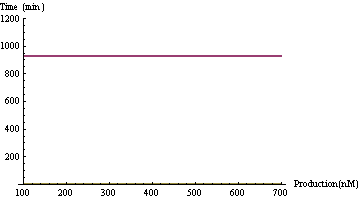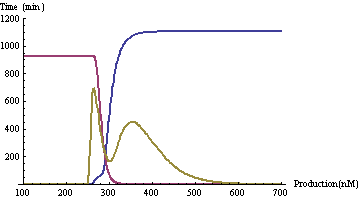Team:PKU Beijing/Modeling/Result
From 2009.igem.org
(→Result - T3 RNA Polymerase) |
(→Result - T3 RNA Polymerase) |
||
| Line 76: | Line 76: | ||
|Simulation Result||Remarks and Explanations | |Simulation Result||Remarks and Explanations | ||
|- | |- | ||
| - | + | |No Memory||Food||[[Image:PKU_T3_nomemory_food.PNG|200px]] | |
| - | |Food||[[Image:PKU_T3_nomemory_food.PNG]] | + | |
||We give the dog a food stimulus at 250 min, and we can see there's a large GFP peak, which means the dog reacts to the food. Since there's no training, the memory state(CI, CI434) doesn't change | ||We give the dog a food stimulus at 250 min, and we can see there's a large GFP peak, which means the dog reacts to the food. Since there's no training, the memory state(CI, CI434) doesn't change | ||
|- | |- | ||
| - | | | + | | ||Bell |
| - | |[[Image:PKU_T3_nomemory_bell.PNG]] | + | |[[Image:PKU_T3_nomemory_bell.PNG|200px]] |
||We only give the dog a bell stimulus at 250 min. The memory state is not affected by this process, and we can't see any dynamics of GFP in this figure. | ||We only give the dog a bell stimulus at 250 min. The memory state is not affected by this process, and we can't see any dynamics of GFP in this figure. | ||
|- | |- | ||
| - | |[[Image:T3_nomemory_bell2.PNG]] | + | | || ||[[Image:T3_nomemory_bell2.PNG|200px]] |
||However, if we zoom in, there's a small GFP peak, which we regard as no output. | ||However, if we zoom in, there's a small GFP peak, which we regard as no output. | ||
|- | |- | ||
| - | |Food+Bell||[[Image:T3_nomemory_both.PNG]] | + | | ||Food+Bell||[[Image:T3_nomemory_both.PNG|200px]] |
||At 250 min, both food stimulus and bell stimulus are presented. The dog reacts strongly. From the simulation result, we can conclude these facts:<br> | ||At 250 min, both food stimulus and bell stimulus are presented. The dog reacts strongly. From the simulation result, we can conclude these facts:<br> | ||
1. There're two GFP peak. Firstly, it means the dog has successfully reacted to the stimuli, which accords to the truth table. However, you may wonder why there're two peaks. That's because there're two procedures which can lead to GFP output. The first one is the food(Sal) directly interacted with the OR Gate and Output module, which causes GFP production. Meanwhile, since both stimuli present, the signals pass through AND Gate 1 module and turn the bistable from CI434 state to CI state, which means the dog starts to remember the relationship between the two stimuli. As a result of that, the mRNA production of T3 increases, as you may mention that the promoters of T3 and CI are exactly same. Since Aa-tRNA(production activated by bell stimulus) still exists, the signals of T3 mRNA and Aa-tRNA pass through AND Gate 2 and finally, the OR Gate and Output module. Since there're a lot of reactions involved, you can see there's a time delay of approx. 100 min. <br> | 1. There're two GFP peak. Firstly, it means the dog has successfully reacted to the stimuli, which accords to the truth table. However, you may wonder why there're two peaks. That's because there're two procedures which can lead to GFP output. The first one is the food(Sal) directly interacted with the OR Gate and Output module, which causes GFP production. Meanwhile, since both stimuli present, the signals pass through AND Gate 1 module and turn the bistable from CI434 state to CI state, which means the dog starts to remember the relationship between the two stimuli. As a result of that, the mRNA production of T3 increases, as you may mention that the promoters of T3 and CI are exactly same. Since Aa-tRNA(production activated by bell stimulus) still exists, the signals of T3 mRNA and Aa-tRNA pass through AND Gate 2 and finally, the OR Gate and Output module. Since there're a lot of reactions involved, you can see there's a time delay of approx. 100 min. <br> | ||
Revision as of 05:33, 20 October 2009
|
||||||||||||||||||||||||||||||||||||||
|
||||||||||||||||||||||||||||||||||||||
 "
"




